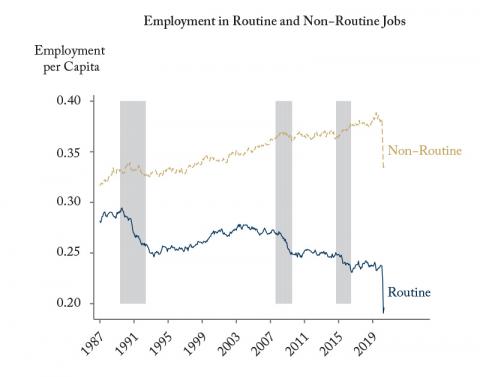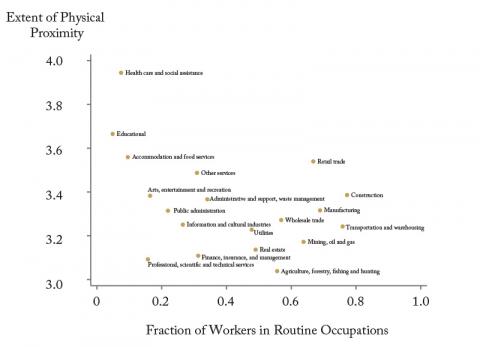From: Joel Blit
To: Canadians concerned about jobs
Date: July 16, 2020
Re: COVID-19 Will Transform Our Economy – If We Get Our Policies Right
Due to the COVID-19 crisis, our economy is undergoing a transformation of unprecedented proportions. This transformation will increase productivity, but more than half a million jobs could be lost due to automation and reallocation.
Since the beginning of the information and communications technology revolution, routine jobs have been disappearing from the Canadian economy. While non-routine employment per capita increased from 31.6 percent to 38.2 percent between January 1987 and January 2020, routine employment per capita fell from 28.1 percent to 23.8 percent.
This decline of routine jobs has not been steady, but rather occurs in predictable bursts; whenever Canada experiences economic downturns, routine jobs are destroyed and never come back. In fact, as shown in Figure 1, the entirety of aggregate routine job losses over the last 30 years occurred during the three major downturns.
Notes: Economic recessions (and the 2015 downturn) are shaded
Sources: Blit, J. 2020. “Could increased productivity be COVID-19’s silver lining?” Forthcoming in Canadian Public Policy Special Issue on COVID-19; Federal Reserve Bank of St. Louis Economic Data; Labour Force Survey (PUMFs)
The loss of routine jobs during recessions (and downturns) is due both to within-firm automation and between-firm reallocation. Firms are more likely to engage in automation during recessions because of lower opportunity costs, increased manager focus on efficiency, and/or changes to the relative costs and benefits of layoffs. In addition, recessions are turbulent economic times where market share and productive resources are reallocated from less productive (or maladapted) firms to more productive ones. Both mechanisms result in a reduction in routine employment and increased aggregate productivity.
Our economy will experience the same transformation during the current COVID-19 crisis. The self-imposed lockdown means the recession we are now facing is real. Where this crisis is likely to be different is in the scale of transformation.
Superimposed onto the usual recessionary forces of industrial transformation, are COVID-specific health incentives to automate. By replacing workers with algorithms and robots, firms not only help mitigate the risk of infection, they also reduce risk to their operations. Moreover, firms that are already more highly automated will suffer less significant disruption to operations and therefore increase market share. It would thus not be surprising to see a higher fraction of routine jobs being permanently lost than in previous recessions. During the 1991 recession, 8 percent of routine jobs were lost. If the same fraction is lost this time, it would imply more than half a million lost jobs.
This transformation will not manifest equally across all industries. Health-related incentives to automate differ across sectors, as does the feasibility of doing so. One proxy for health-related incentives to automate is, for each industry, the fraction of workers whose job requires close physical proximity to other people. Feasibility can be measured as the fraction of workers that are employed in routine occupations. Figure 2 shows where different industries lie along these dimensions.
Source: Blit, J. 2020. “Could increased productivity be COVID-19’s silver lining?” Forthcoming in Canadian Public Policy Special Issue on COVID-19.
Healthcare and social assistance exhibits the highest average physical proximity among workers and hence the strongest health-related incentives to automate. However, it is not clear that significant automation is feasible in healthcare given current technologies. The sectors that are likely to experience the most pronounced transformations are those residing in the top right of the Figure: retail trade, construction, manufacturing, and transportation and warehousing. Among these, retail trade stands out as the biggest candidate.
Not surprisingly, retail is in fact the industry where we have seen the biggest headlines trumpeting change. Walmart recently announced a pilot cashier-less store as it looks to limit human interaction while speeding checkout. Across the industry, market share and productive resources are flowing from brick and mortar stores to more highly automated online stores.
That change is afoot cannot be disputed. What remains to be determined is how best to respond to the challenges and opportunities presented by the crisis. To date, government economic responses have focused on supporting businesses to ensure their survival, subsidizing wages to save jobs, and offering financial support to affected Canadians. In short, policies have aimed to maintain the status quo. But as we put the worst of the crisis behind us, we must embrace change so as to emerge stronger on the other side.
Wage subsidies must be removed so that firm incentives to automate and increase productivity are not stifled. Ultimately, firms that are unproductive or are maladapted to the new ongoing reality must be allowed to fail so that their resources can be reallocated.
The artificial intelligence and robotics revolution that we have been expecting is now at our doorstep. We should embrace it by removing barriers to technological change, by helping to finance investments that make our firms more competitive, and by mobilizing the knowledge that resides in our universities and institutes. The latter is particularly important for Canada’s small- and medium-sized businesses.
To be sure, this transformation will entail significant labour market disruption. We should be prepared to assist workers with financial supports like extended employment insurance or a guaranteed basic income (which might naturally evolve from the CERB). Retraining programs could be offered in partnership with colleges and universities. Many affected workers will become under-employed or join the gig economy and we must ensure that assistance also applies to them. The time is now to embark on transformational change, when opportunity costs are lower due to an already upended labour force.
We are in the midst of an historic opportunity. The wave of solidarity and belief in the important role of government presents an opening to reimagine our social safety net, not just to help individuals through this transition, but also to create the institutions and programs that will ensure all Canadians share in the benefits of technology today and for generations to come.
With the right policies, a richer and fairer Canada may emerge.
Joel Blit is Associate Professor of Economics at the University of Waterloo.
To send a comment or leave feedback, email us at blog@cdhowe.org.
The views expressed here are those of the author. The C.D. Howe Institute does not take corporate positions on policy matters.







